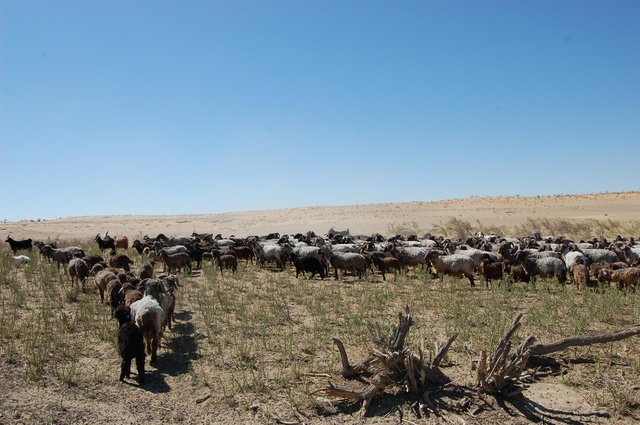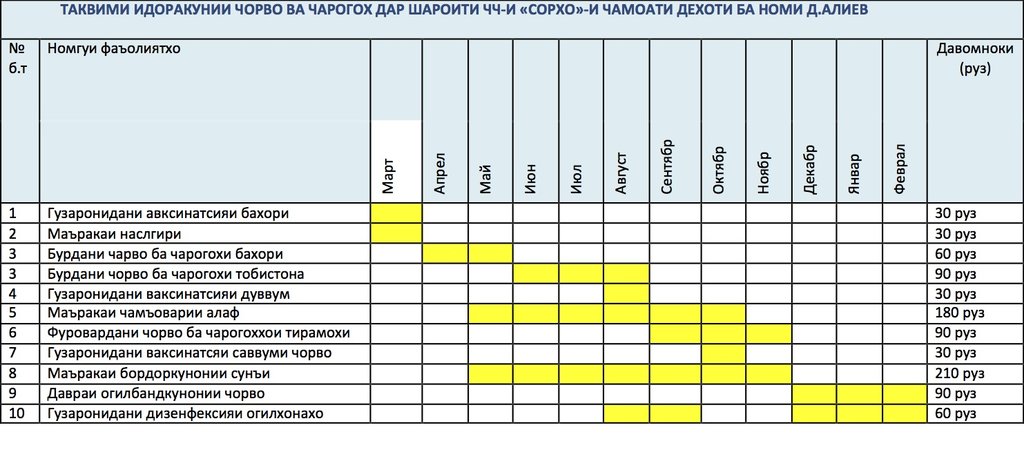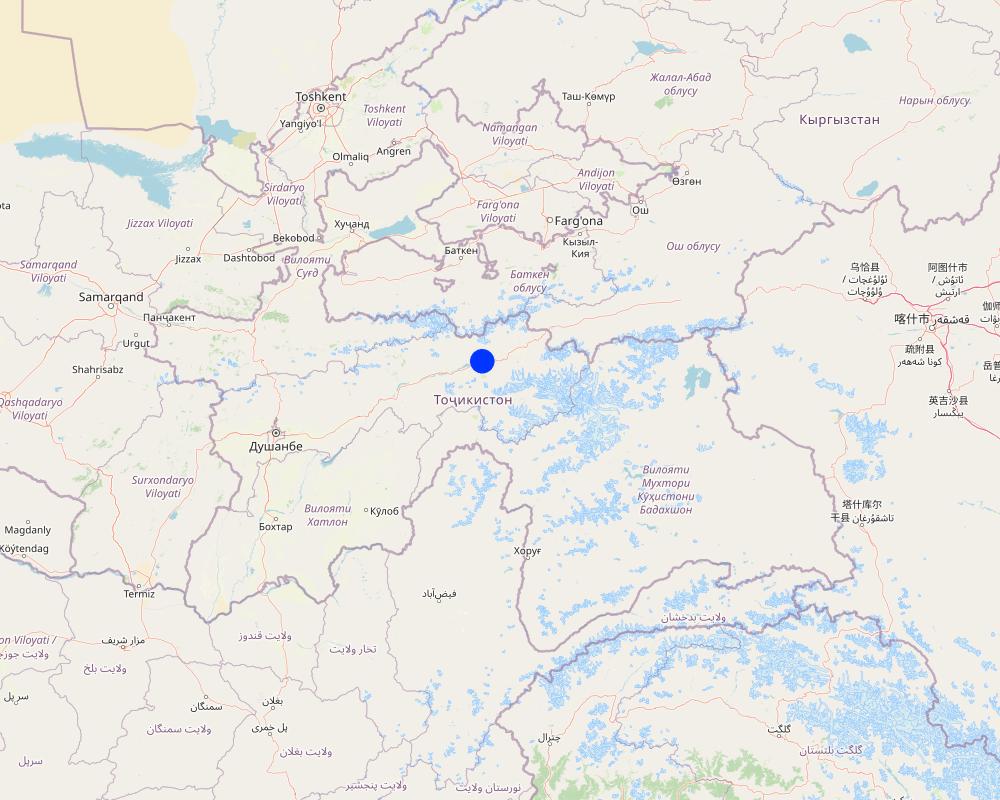Pasture Calendar [طاجيكستان]
- تاريخ الإنشاء:
- تحديث:
- جامع المعلومات: Askarsho Zevarshoev
- المحرر: –
- المراجعون: Yacime Khadraoui, Maximilian Knoll, Joana Eichenberger
Таквими чарогохистифодабари
approaches_3466 - طاجيكستان
عرض الأقسام
توسيع الكل طي الكل1. معلومات عامة
1.2 تفاصيل الاتصال بالأشخاص الرئيسيين لمصدر المعلومات والمؤسسات المعنية بتقييم وتوثيق النهج
متخصص في الإدارة المستدامة للأراضي:
اسم المشروع الذي سهّل توثيق/تقييم النهج (إذا كان ذلك على صلة)
Environmental Land Management and Rural Livelihood Projectاسم المؤسسة (المؤسسات) التي سهلت توثيق/تقييم النهج (إذا كان ذلك على صلة)
Aga Khan Foundation (AKF) - سويسرا1.3 الشروط المتعلقة باستخدام البيانات الموثقة من خلال WOCAT
متى تم تجميع البيانات (ميدانيا)؟:
20/12/2016
يوافق جامع المعلومات والشخص (لاشخاص) الرئيسي لمصدر المعلومات على الشروط المتعلقة باستخدام البيانات الموثقة من خلال WOCAT:
نعم
1.4 المراجع الخاصة باستبيان(استبيانات) تقنيات الإدارة المستدامة للأراضي

Ротация пастбищ в пустынных регионах Узбекистана (ИСЦАУЗР) [أوزبكستان]
Усовершенствование схемы выпаса скота, обеспечивающее восстановление пастбищной растительности и соблюдение нормативной нагрузки на пастбища.
- جامع المعلومات: Rustam Ibragimov
2. وصف نهج الإدارة المستدامة للأراضي
2.1 وصف موجز للنهج
Pasture calendar services the PUU as part of the implementation of the plan with a specific timeframe and activities. It helps communities in designing intervention with regard to the need of agreed activities in the calendar.
2.2 وصف تفصيلي للنهج
وصف تفصيلي للنهج:
Pasture calendar is a composition of different activities and events within the PLMP of the PUU, where concrete timeframes for each events and activities are defined. PUUs were supported to develop their pasture calendar with specific activities related to pasture use and management with supervision of the PUU management. All the eight PUUs have their own pasture calendar, because the timeframes for each PUU is different. This is caused by different altitudes, that result in different timeframes for different events. For example in Jirgatal movements to the summer pastures start in May, in a lower district like Faizabad and Roghun it starts one or half a month earlier. This will help the PUUs to coordinate the livestock movement and applying different techniques in the right time. Another important element is that for each activity a responsible person or team is identified. Roles and responsibility are shared while considering gender aspects aswell. For example, specific tasks in livestock and pasture management, where women's roles are more crucial enable them to participate in planning and decision making.
2.3 صور عن النهج
ملاحظات عامة بخصوص الصور:
The calendar format can be shaped differently depending on the community's willingness on what kind of information they want to put there. The information is agreed on with community during development of their pasture management plan, where the pasture calendar is also integral part of this plan.
2.5 البلد/المنطقة/المواقع التي تم تطبيق النهج فيها
البلد:
طاجيكستان
المنطقة/الولاية/المحافظة:
Rasht Valley/Faiobod District
مزيد من التفاصيل حول الموقع:
sub-district of D. Aliev, PUU Sohru at sub-district level
التعليقات:
Coordinates of Location: Latitude - 39. 18 2: Longitude - 71 044
Map
×2.6 تواريخ بدء وإنهاء تنفيذ النهج
في حالة عدم معرفة السنة بالتحديد، يرجى الإشارة إلى التاريخ التقريبي لبدء النهج:
منذ أقل من 10 سنوات (مؤخرًا)
2.7 نوع النهج
- قائم على مشروع/برنامج
2.8 الغايات/الأهداف الرئيسية للنهج
The main aim of this approach is to organize activities within the given timeframe on pasture management. In this example support was provided to PUU to identify and plan the activities in a structured way for sustainable pasture management.
2.9 الظروف التي تمكن أو تعيق تنفيذ التقنية/التقنيات المطبقة بموجب النهج
توفر/الوصول إلى الموارد والخدمات المالية
- تمكين/تمكيني
No major financial resource is required, only the motivation of communities and PUU members is needed, however as part of the pasture planning workshop session, some resource are needed for organizing the workshop.
الإطار المؤسساتي
- تمكين/تمكيني
The process is run by the legally registered institute - Pastue User Union established according to the Pasture Law.
التعاون/التنسيق بين الجهات الفاعلة
- تمكين/تمكيني
Once the detailed activities on pasture use are identified collaboration with other involved stakeholders based on the analysis will take place.
الإطار القانوني (حيازة الأراضي، وحقوق استخدام الأراضي والمياه)
- تمكين/تمكيني
PUU in the framework of Pasture Law of the Republic of Tajikistan is registered.
المعرفة حول الإدارة المستدامة للأراضي، والوصول إلى الدعم الفني
- تمكين/تمكيني
The project staff have pasture specialists who train and build the capacity of PUU members.
3. المشاركة وأدوار الأطراف المعنية
3.1 أصحاب المصلحة المعنيون بالنهج وأدوارهم
- مستخدمو الأراضي المحليون/المجتمعات المحلية
livestock owners, PUU members
active participation in the identification of main activities related to pasture management
- متخصصون في الإدارة المستدامة للأراضي / مستشارون زراعيون
project specialist
provide technical support in development and design of pasture calendar
- الحكومة المحلية
land committee, forestry department, agriculture deparment
supervise the implementation plan, support with providing advisory services also
3.2 انخراط مستخدمي الأراضي المحليين/المجتمعات المحلية في المراحل المختلفة للنهج
| انخراط مستخدمي الأراضي المحليين/المجتمعات المحلية | حدد من شارك وصف الأنشطة | |
|---|---|---|
| المبادرة/التحفيز | تفاعلي | The development of the calendar depends on the initiative of the other stakeholders. If there is no consent with others, it is possible it will not be implemented. |
| التخطيط | تفاعلي | It includes roles and responsibilities of different stakeholders, where an interactive approach is required for planning. |
| التنفيذ | الدعم الخارجي | The pasture calendar reflects the whole range of activities which are planned to implement in a given timeframe. For the implementation of some of the activities some external support both financial and technical is required, which was provided by the project staff and funding from various sources, including government and internal community fund, as well as donor fudings. |
| الرصد/التقييم | الدعم الخارجي | With the guidance from the project team, which also has monitoring and evaluation experts monitoring had been conducted jointly with PUUs member. In addition, the implementing agencies for the ELMARL project, such as MSDSP, have also their monitoring and evaluation departments which carried out monitoring aswell. |
3.4 اتخاذ القرار بشأن اختيار تقنية/تقنيات الإدارة المستدامة للأراضي
حدد من الذي قرر اختيار التقنية/التقنيات التي سيتم تنفيذها:
- متخصصون في الإدارة المستدامة للأراضي بشكل أساسي، بعد التشاور مع مستخدمي الأراضي
اشرح:
Project technical team, which supported the development of the pasture calendar shared expertise on the technical aspects of activities by considering local knowledge from land users and mainly decided on the selection of technology.
حدد على أي أساس تم اتخاذ القرارات:
- خبرة وآراء شخصية(غير موثقة)
4. الدعم الفني وبناء القدرات وإدارة المعرفة
4.1 بناء القدرات/التدريب
هل تم تقديم التدريب لمستخدمي الأراضي / الأطراف المعنيين الآخرين؟:
نعم
حدد من تم تدريبه:
- مستخدمو الأراضي
- موظفون ميدانيون/ مستشارون
إذا كان ذلك على صلة، حدد الجنس والعمر والوضع والعرق وما إلى ذلك.
Usually the project tried to provide gender balance in attending the trainings (50% to 50%). The main focus was on youth and women who were actively involved in taking care of livestock.
شكل التدريب:
- اجتماعات عامة
- دورات
المواضيع المغطاة:
Pasture management. preparation of the pasture calendar, land management
4.2 خدمة استشارية
هل يملك مستخدمو الأراضي وصولا إلى خدمة استشارية؟:
نعم
حدد ما إذا كانت الخدمة الاستشارية متوفرة:
- في حقول مستخدمي الأراضي
وصف/تعليقات:
by project staff and also specialist from land and pasture committee, environmental committee
4.3 تعزيز المؤسسات (التطوير التنظيمي)
هل تم إنشاء أو تعزيز مؤسسات من خلال هذا النهج؟:
- لا
4.4 الرصد والتقييم
هل يشكل الرصد والتقييم جزءا من النهج؟:
كلا
4.5 البحوث
هل كانت البحوث جزءًا من النهج؟:
كلا
5. التمويل والدعم المادي الخارجي
5.1 الميزانية السنوية لمكون الإدارة المستدامة للأراضي في النهج المذكور
أشر إلى ميزانية النهج السنوية لمكون الإدارة المستدامة للأراضي بالدولار الأمريكي:
198,00
التعليقات (على سبيل المثال المصادر الرئيسية للتمويل/الجهات المانحة الرئيسية):
World Bank and IFAD
5.2 الدعم المالي/المادي المقدم لمستخدمي الأراضي
هل حصل مستخدمو الأراضي على دعم مالي/ مادي لتنفيذ التقنية/ التقنيات؟:
نعم
إذا كانت الإجابة بنعم، حدد نوع (أنواع) الدعم والشروط والمزودين:
The ELMARL project financed by World Bank supported the PUUs with implementation of the pasture plan, including support with follow up on pasture calendar.
5.3 إعانات لمدخلات محددة (بما في ذلك العمالة)
- غير موجود
- معدات
| حدد المدخلات التي تم دعمها | إلى أي مدى | حدد الإعانات |
|---|
إذا كان العمل من قبل مستخدمي الأراضي مدخلاً جوهريًا، فهل كان:
- تطوعي
التعليقات:
The labour in all project was considered as contribution from the PUUs and therefore was shared voluntary.
5.4 الائتمان
هل تم توفير ائتمان في إطار نهج أنشطة الإدارة المستدامة للأراضي؟:
كلا
5.5 حوافز أو وسائل أخرى
هل تم استخدام حوافز أو أدوات أخرى لتشجيع تنفيذ تقنيات الإدارة المستدامة للأراضي؟:
كلا
6. تحليل الأثر والتصريحات الختامية
6.1 آثار النهج
هل ساهم النهج في تمكين مستخدمي الأراضي المحليين وتحسين مشاركة الأطراف المعنية؟:
- لا
- نعم، قليلا
- نعم، باعتدال
- نعم، إلى حد كبير
Sets exact timeframe with activities to follow on and contributes to sustainable management of pasture resources.
the pasture calendar is developed in a participatory way, where decision is made in the same time with evidence base
هل أدى النهج إلى تحسين معرفة وقدرات مستخدمي الأراضي على تنفيذ الإدارة المستدامة للأراضي؟:
- لا
- نعم، قليلا
- نعم، باعتدال
- نعم، إلى حد كبير
In time implementation of activities also motivates and contributing to implement SLM successfully.
هل أدى النهج إلى تحسين معرفة وقدرات الأطراف المعنية الأخرى؟:
- لا
- نعم، قليلا
- نعم، باعتدال
- نعم، إلى حد كبير
Various training as part of the implementation of the approach were provided to the land users to enable them in development of this approach and implementation.
هل ساهم النهج في التخفيف من حدة الصراعات؟:
- لا
- نعم، قليلا
- نعم، باعتدال
- نعم، إلى حد كبير
When communities developed their pasture calendar, they agreed on the planned activities among each other, which mitigated conflict.
هل ساهم النهج في تمكين الفئات المحرومة اجتماعيا واقتصاديا؟:
- لا
- نعم، قليلا
- نعم، باعتدال
- نعم، إلى حد كبير
Especially women and youth were involved in preparing the pasture calendar and were actively involved in decision making.
هل أدى النهج إلى تحسين المساواة بين الجنسين وتمكين النساء والفتيات؟:
- لا
- نعم، قليلا
- نعم، باعتدال
- نعم، إلى حد كبير
Women were involved in preparing the pasture calendar, where most of the planned activities implementation depended on women. In this process women were actively involved in making decision with regards to those activities where they were actively involved.
6.2 المحفز الرئيسي لقيام مستخدمي الأراضي بتنفيذ الإدارة المستدامة للأراضي
- الحد من تدهور الأراضي
contribute to rotational and seasonal use of pasture, which allows rehabilitation of degraded pasture
- انخفاض عبء العمل
The timeframe in the pasture calendar identified a responsible person per each activities, which shared the workload among the community members.
- القواعد واللوائح (الغرامات) / الإنفاذ
The approach sets certain rules and regulations and responsible persons to enforce implementation of the planned activities.
- الوعي البيئي
Beside economic benefits, the approach also sets activities to follow on the environmental aspects of pasture management. This also raised awareness among PUUs members on ecological consciousness.
6.3 استدامة أنشطة النهج
هل يمكن لمستخدمي الأراضي المحافظة على استدامة ما تم تنفيذه من خلال النهج (بدون دعم خارجي)؟:
- غير مؤكد
إذا كان الجواب لا أو غير متأكد، حدد ذلك وعلق عليه:
Development of the pasture calendar does not guarantee full implementation of activities unless there is a sustainable mechanism for incentives in place.
6.4 نقاط قوة/مزايا النهج
| نقاط القوة/ المزايا/ الفرص من وجهة نظر مستخدمي الأراضي |
|---|
| straight forward, easy understandable/and potential for replicaiton |
| نقاط القوة/ المزايا/ الفرص من وجهة نظر جامع المعلومات أو غيره من الاشخاص الرئيسيين لمصدر المعلومات |
|---|
| easy development and doable/brings together all stakeholders in one room to jointly plan their activities with regards to pasture and livestock management/can be applied by communities without external support |
6.5 نقاط الضعف/ العيوب في المنهج وطرق التغلب عليها
| نقاط الضعف/ المساوىء/ المخاطر من وجهة نظر مستخدم الأراضي | كيف يمكن التغلب عليها؟ |
|---|---|
| depends on all involved stakeholders | required to strengthen collaboration between different stakeholder |
| نقاط الضعف/ المساوىء/ المخاطر من وجهة نظر جامع المعلومات أو غيره من الاشخاص الرئيسيين لمصدر المعلومات | كيف يمكن التغلب عليها؟ |
|---|---|
| very theoretic and not easy to adjust to real implmentation and straight forward only reflects one steps | should be considered as integral part of the overall pasture and livestock management approach |
7. المراجع والروابط
7.1 طرق جمع/مصادر المعلومات
- مقابلات مع مستخدمي الأراضي
3
- مقابلات مع المتخصصين/الخبراء في الإدارة المستدامة للأراضي
1
7.2 المراجع للمنشورات المتاحة
العنوان، المؤلف، السنة، النظام القياسي الدولي لترقيم الكتب ISBN:
Pasture and Livestock Management of Pasture Use Unions Sorhu, Faizabad District, D. Aliev sub-district, Tajikistan
متاح من أين؟كم التكلفة؟:
Zevarshoev Askarsho, free of cost
7.3 روابط للمعلومات ذات الصلة المتوفرة على الإنترنت
العنوان/الوصف:
Secretariat of the Tajik Pasture Management Networking Platform
عنوان الرابط URL:
https://pasture.klink.asia/dms/documents
الروابط والوحدات المواضيعية
توسيع الكل طي الكلالروابط

Ротация пастбищ в пустынных регионах Узбекистана (ИСЦАУЗР) [أوزبكستان]
Усовершенствование схемы выпаса скота, обеспечивающее восстановление пастбищной растительности и соблюдение нормативной нагрузки на пастбища.
- جامع المعلومات: Rustam Ibragimov
الوحدات المواضيعية
لا يوجد وحدات مواضيعية





